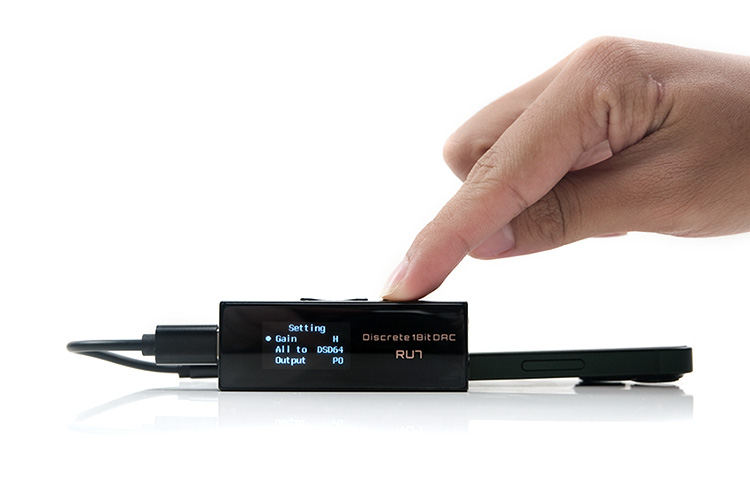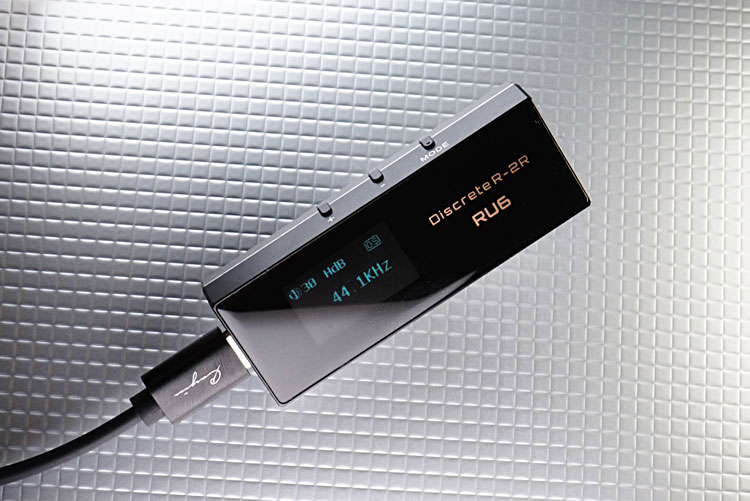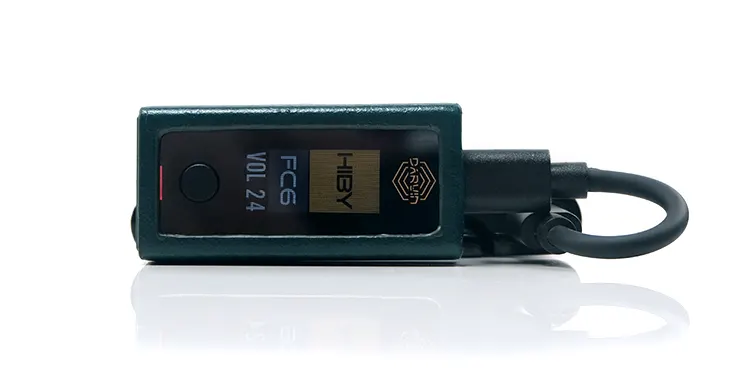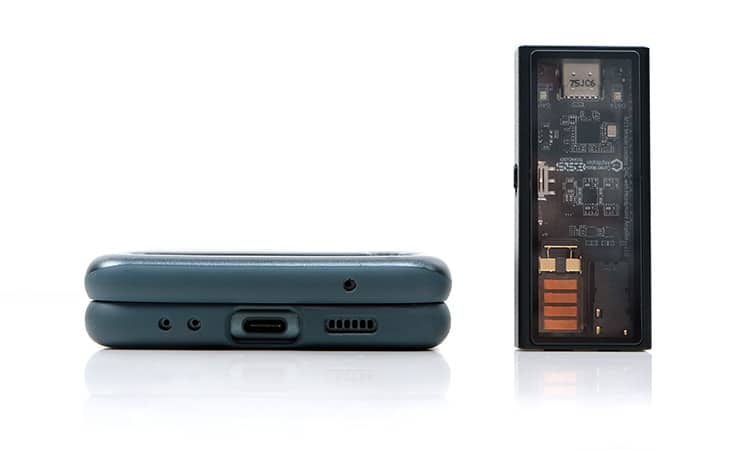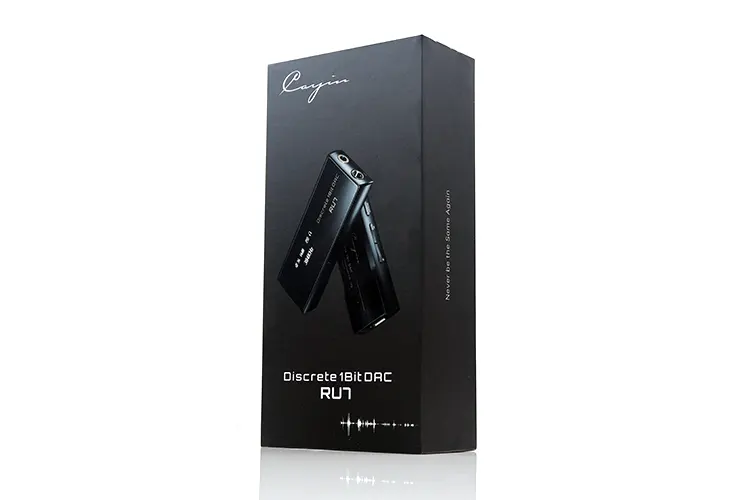Select Comparisons
The following comparisons were completed using a Samsung S23 Ultra and an Apple iPhone 13 Mini as our main transports. For IEMs and headphones, we used the Noble Audio Ronin, the 64 Audio Trio, and the Meze Audio Elite headphones.
Cayin RU6
The Cayin RU6 was the company’s debut dongle as well as the first-ever dongle to be launched using R-2R technology. It was also our Top Gear 2021 Award winner. You can read our full review of the RU6 here from the same year.
Technical
Neither the RU6 nor the RU7 uses any sort of classic delta-sigma chipset. The RU6 differs by using more of a classic R-2R resistor ladder network whereas the RU7 uses a 1-BIT DAC though both are discrete topologies.
There is a different emphasis in the design approach regarding temperature and precision tolerance being much more exacting for R-2R compared to 1-BIT which switches its focus more on noise shaping and achieving a clean power supply.
Also, for the RU6, both DSD and PCM go through the same multi-bit, (24BIT) conversion and upsampling process before being decoded. Whereas all digital audio goes from PCM to DSD, (all-to-DSD), inside the RU7.
Decoding levels are similar at DSD256 and PCM 32BIT/384kHz and both have sampling options though the basis for each is quite different. For the RU6 you have the classic NOS/OS option whereas the RU7 will offer you an “All-To-DSD” allowing you to process all audio from DSD64 to DSD256. Both will alter the tonal presentation in appreciable ways.
Output power is where there is a more considerable difference. Both their SE outputs are in the same ballpark at 138mW for the RU6 and 160mW for the RU7 on a 32Ω load. However, the RU7 has a much stronger PO for its balanced 4.4mm output at 400mW compared to just 213mW for the RU6 on the same load.
The RU6 also lacks the dual line-out functionality of the RU7 making it purely a dongle DAC for headphone use rather than having additional pure DAC functionality.
Design
In some ways moving from the RU6 to the RU7 in terms of design, form factor and some aspects of functionality is akin to seeing how Cayin itself has developed in terms of dongle DAC product development.
Granted, both have a similar look and vibe with matching core materials of aluminum with glass paneling. However, the RU7 is lighter, smaller, and more refined in terms of its finishing on the housing with additional guards on the base panel to protect the connections. The switch to a horizontal button alignment also feels more intuitive.
Both do offer both a balanced and a single-ended output capability but you have to also remember the additional LO for both sockets on the RU7. That switches a lot of its usage potential to becoming a micro-DAC of sorts and that is where a lot of value add becomes very apparent.
The inclusion of the additional green leather case where the original was lacking is worth a mention. It is a more attractive case compared to the orange version in my eyes but also a tighter case with less potential for sliding off.
The screen real estate is the same, it’s the same OLED panel on both dongles. However, the RU7 default brightness level is set a little higher than the RU6. Some might find the lack of glare on the RU6 to present a seemingly more refined readout. Others might wish for clearer legibility in lower light.
Performance
I think there is room for both dongles here and I would not automatically assume the RU6 is an inferior product. There were some pairings I found the RU6 tonal profile to be more suited over the RU7 and vice versa.
For example, the 64 Audio Trio and the RU6’s smoother and sweeter tuning were more pleasing than the thicker but comparatively more linear character of the RU7. Not that the RU7 has a neutral coloration per se, but rather the timbre is warm to natural with more neutral imaging rather than sweet, and mid-forward.
The RU7 on DSD64 mode will give you a thicker slightly less revealing sound that meshes quite well with the Trio’s peppy treble overtone but it does come at the cost of the RU7’s excellent DSD256 imaging capability. However, on DSD256 I felt the pairing was a bit too clean and not as ’embracing’ as the RU6’s more liquid sound signature, especially with vocals.
The extension and response of the Trio dynamic driver were more impressive with the RU7. The RU6 has more upper bass and lower mids bloom but it lacks the sub-bass presence of the RU7, something which is also replicated on the Noble Audio Ronin which is where the RU7 really shines.
The Ronin has a warmer character but also a flatter bass response. The RU7’s beefier sub-bass tuning gave this pairing a bit more heft and a solid bass fundamental compared to the RU6.
The additional resolution and treble extension from the DSD256 RU7 mode also injected some improved clarity and improved separation over the more analog and slightly less resolving RU6.
The Ronin is a spacious-sounding monitor, something which the RU7’s superior separation and more holographic staging can take advantage of on the highest “all-To-DSD” setting.
HiBy FC6
The HiBy FC6 is the newest dongle DAC from the company and also features R-2R technology. You can read our recent full review of the FC6 here.
Technical
Like the RU6, the FC6 is another R-2R dongle so we will not really into the differences once again between the 1-BIT architecture and traditional R-2R.
But we should point out a few things that the FC6 leads with. The most important of which is that its discrete circuit is a single-ended design as opposed to the RU7’s balanced circuit.
That means you get one 3.5mm output with the FC6 whereas the RU7 comes equipped with both 4.4mm balanced and 3.5mm SE as well as dual LO functionality up to 2.4Vrms. Not only do you get a lot more output power for more demanding headgear from the RU7 at up to 400mW compared to 100mW on a 32Ω load but you also have a pure DAC mode option for the RU7.
It is also worth noting that HiBy has a more ‘holistic’ view of the FC6 DAC implementation where R-2R is but one component in their overarching “Darwin Architecture”. That means there is a stronger emphasis and capability in introducing various filtering options in its OS mode whereas the RU7’s main DSP focus is on its “All-to-DSD” sampling capability.
The FC6 does have an edge in decoding capability with an excellent DSD512 and PCM 32BIT/768kHz capability as well as MQA 8X unfolding. The RU7 is capped at DSD256 and PCM 32BIT/384kHz and has no MQA unfolding capability albeit there is some debate on how useful that will be in the long term.
Design
The RU7 may have gotten a lot more compact compared to the RU6 but it still looks huge beside the petite FC6. I have to take my hat off to HiBy for being able to get an R-2R capable dongle DAC down to this size though I wonder if the loss of a balanced output was the sacrificial lamb as a result.
Still, even at this size the colored screen and large font application make it a joy to use. Do not get me wrong, the RU7 has improved over the RU6 with its redesigned control array and higher brightness levels but its more basic display and slightly more elongated control drill-down give the FC6’s more immediate central button control the edge.
I/O belongs to the RU7 and then some. Not only can you go balanced or single-ended PO but you can do the same in LO mode giving you much more versatility. The FC6 is purely for PO with IEM and some efficient headphone usage though, like the RU7, it can operate as a USB-DAC for both MAC and PC.
Both dongles come with attractive leather cases. The color schemes complement their DAP case options also in green with the N7/RU7 or a darker green as is the case with the FC6/RS8. The overall packaging is good but I do give the nod to HiBy for their imaginative FC6 packaging which includes a matching carry case.
Performance
The FC6 is more rounded tonally, with a thicker weightier bass performance and a fulsome-sounding midrange and vocal performance. This was with both our tested IEMs, the Trio and the Ronin.
The RU7 will sound relatively wet and analog in tone on DSD64 mode but even then, it’s a more balanced performance both in terms of bass weight and midrange timbre.
The real difference though comes in both the treble presence and headroom as well as the staging performance with the RU7 sounding more capable in both areas, especially when you switch it to its DSD256 mode.
Subtle spatial cues, background vocal layering, and instrumental separation all had much more space to work with in both IEM pairings with the FC6 choosing instead to enhance the key focus points of bass and vocals and coming across as a little muddier for layering in comparison.
Treble is more laid back on the FC6 which actually works to its advantage with brighter monitors such as the Trio and I will admit it does really well to tease out more authority on both the Trio and the Ronin’s lows.
However, it’s not as tight sounding or as revealing so, once you move through the mids and highs, the RU7 is the more resolving of the two dongles.
Now this was with both using their respective SE outputs and dropping the power down. There is enough power for both IEMs to be adequately driven but once you switch to the RU7’s stronger balanced output the amount of channel separation and dynamics was noticeably improved.
Questyle M15
The Questyle M15 was launched by the company in mid-2022 and is a continuation of the technology on a grander scale first seen in the smaller M12. You can read our full review of the M15 here.
Technical
The M15 is a curious mix, an outlier if you will with only its sibling the M12 coming in any way close to its uniqueness. This is a combination of a tried and tested delta-sigma DAC with Questyle’s own current mode amplification.
The onboard DAC inside the M15 is a fairly popular one called the ES9281AC PRO which is a chipset from ESS launched in 2021 and used by various manufacturers and the one you will also find inside the smaller M12.
It’s a huge contrast also to the discrete resistor network array or 1-BIT DAC inside the RU7 with all digital audio signals being upsampled via an SRC multibit converter before being decoded into an analog signal.
OTG decoding from both is on par for lossless with the M15 offering up to DSD256 native and PCM 32BIT/384kHz but with an additional 8X MQA hardware unfolding capability which the RU7 does not have. Instead, the RU7 will give you an “All-to-DSD” upsampling option which brings its own unique flavor to the table.
Both have a balanced output amplification capability with the M15’s current mode amp capable of 112mW into a 32Ω single-ended into a 32Ω and around 212mW balanced into the same load.
The RU7 seems to have the edge here in SE mode but has a much larger advantage going balanced at up to 400mW into the same load. Of the two, the RU7 is going to offer more headroom for less efficient gear.
Design
The M15 is the biggest of the compared dongles volumetrically though slightly shorter than the RU7. It is also more than twice as heavy. This makes it a bit strange then that it lacks a lot of onboard features that you might expect, features that are present in the RU7.
Among them, the lack of an onboard volume control contrasts starkly with the RU7’s onboard discrete-engineered resistor network volume control.
Using a USB-driver-controlled volume adjustment relies a lot on the capability of the OS on any paired platform and in some cases the results are very uneven in terms of being able to control volume on the M15. The RU7’s volume control, on the other hand, is excellent with 99 steps giving you ample headroom for micro-adjustments.
It also lacks any sort of LCD or GUI display relying instead on color-coded RGB lights for both balanced and SE modes as well as the incoming sample rate. To its advantage, however, the simple low and high gain switch on the side is quick and useful avoiding the need for any GUI controls to operate it.
Aesthetically, I love the clear panel looks on the M15. The ability to peer into the innards is a design cue in itself and reeks of confidence from Questyle in their engineering capability. The RU7 housing, however, is more discrete, but also more intricate and engaging with its LCD display and stronger control suite.
Performance
The M15 has excellent dynamics, strong bass performance, and a clean set of mids and highs. However, it cannot compete against the RU7’s holographic soundstage, sounding comparatively narrower and more intimate.
The imaging on the RU7 is more dynamic in its arrangement, especially with the Ronin which really welcomes anything that can fill its superlative width and generally intricate staging quality.
The M15 does not really get beyond a 2D stage despite its rapier-like bass quality and healthy micro-detail retrieval. Little plinks from a background-positioned piano sound duller the further to the left or right and sound indistinct whereas the same simple but tiny cues resonate in a stronger fashion on the RU7.
Tonally, the M15 does have that delta-sigma and ESS Sabre quality sounding more neutral and pristine but slightly drier. Its treble is well extended and can add to a perception of good clarity in the mids so it’s by no means a ‘mushy’ experience. I have commended the M15 highly before for the clarity and power it can bring to the table.
The RU7 tonally, is wetter and fuller sounding despite having a low-end that is a shade more reserved in terms of dynamic impact and speed. It does sound fuller also through the mids, and a little more rounded in its timbre, especially with DSD64 mode which softens the coloration and gives it a more analog quality.
Still, if you want more vocal and instrumental richness in your timbre then the RU7 is the better option. Combined with the improved separation and larger soundstage it is a step up for me over the M15 with the like of the Ronin.
Our Verdict
I have heard quite a few dongles now in the last few years, and all at a roughly similar $200-300 price range. I have not heard all of them. However, from what I have reviewed to date, the RU7 is probably the best of the lot, both in terms of agreeable timbral coloration and technical prowess.
There can be arguments for the RU6’s different approach and I would say the RU7 should not be seen as a direct replacement or even an ‘upgrade’ such are the differences in their tonal emphasis. However, if you are aiming to buy just one of the Cayin dongles to do it all then the RU7 would get my vote.
The additional balanced output power, the technical capability, and several All-To-DSD modes are just some of the key features that elevate and differentiate the RU7 from its peers and the competition.
Cayin RU7 Technical Specifications
- DAC: 1-bit discrete resistor fully-balanced 4-channel DAC
- Volume control: discrete resistor 100-step linear volume control
- FPGA: No
- SNR: 114dB (3.5mm) 112dB (4.4mm)
- Power output: 160mW (3.5mm) 400mW (4.4mm)
- THD+N (32-ohm): 0.006% (3.5mm) 0.008% (4.4mm)
- Dynamic range: 115dB
- Screen: 0.91-inch OLED
- Audio formats (PCM): 16/24/32-bit 44.1-384KHz
- Audio formats (DSD): DSD64-256
- Dimensions: 66mm x 24mm x 12mm
- Weight: 25g

